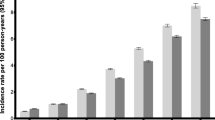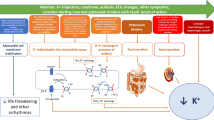Abstract
Background/objective: Drugs have been recognised as a primary or contributing cause of hyperkalaemia, especially when administered to patients with underlying risk factors. The objective of this study was to analyse the influence of the known risk factors for hyperkalaemia on the velocity of the development of hyperkalaemia.
Study design/methods: Clinical characteristics, laboratory data and medication profiles of patients developing hyperkalaemia (serum potassium ≥5.0 mmol/L) hospitalised between 2000 and 2004 in the University Hospital Basel, Switzerland, were recorded. Factors associated with a high velocity of the development of hyperkalaemia were detected using a multiple logistic regression model. Subsequently, the velocity during a defined observation period was compared between patients with one risk factor and patients with two or more risk factors. Finally, the dose effects of drugs identified as risk factors for a high velocity of the development of hyperkalaemia were analysed using two sample comparisons.
Results: A random sample of 551 hospitalised patients was analysed. Compared with the drug treatment at entry, significantly more patients during the hospitalisation were treated with drugs associated with hyperkalaemia, such as heparins (p < 0.001), ACE inhibitors or angiotensin receptor blockers (ARBs) [p = 0.002], potassium supplements (p < 0.001), potassium-sparing diuretics (p < 0.001) and/or NSAIDs or selective cyclo-oxygenase (COX)-2 inhibitors (p < 0.001). Risk factors associated with a high velocity of the development of hyperkalaemia were use of potassium supplements (adjusted odds ratio [OR] 3.386; 95% CI 2.251, 5.091), severe renal impairment (OR 3.119; 95% CI 2.007, 4.850), use of ACE inhibitors or ARBs (OR 2.642; 95% CI 1.742, 4.006), use of potassium-sparing diuretics (OR 2.065; 95% CI 1.310, 3.254), and diabetes mellitus (OR 1.525; 95% CI 1.005, 2.313). The velocity of the development of hyperkalaemia significantly increased in patients with two or more risk factors. Dose effects could be found for potassium supplements (p = 0.006) and potassium-sparing diuretics (p = 0.007), but not for ACE inhibitors or ARBs (p = 0.289). In contrast, the use of kaliuretics (loop diuretics or thiazides) was associated with a decreased velocity of the development of hyperkalaemia in patients with serious renal impairment (p = 0.016) and in patients treated with two or more drug classes associated with a high velocity of the development of hyperkalaemia (p = 0.001).
Conclusions: Risk factors associated with a high velocity of the development of hyperkalaemia are use of potassium supplements > severe renal impairment > use of ACE inhibitors or ARBs > use of potassium-sparing diuretics > diabetes mellitus. The presence of two or more of these risk factors is associated with an even faster development of hyperkalaemia. Clinicians should be aware of these risk factors in order to avoid a rapid development of potentially life-threatening hyperkalaemia.






Similar content being viewed by others
References
Schaefer TJ, Wolford RW. Disorders of potassium. Emerg Med Clin North Am 2005 Aug; 23(3): 723–47
Perazella MA. Drug-induced hyperkalemia: old culprits and new offenders. Am J Med 2000 Sep; 109(4): 307–14
Acker CG, Johnson JP, Palevsky PM, et al. Hyperkalemia in hospitalized patients: causes, adequacy of treatment, and results of an attempt to improve physician compliance with published therapy guidelines. Arch Intern Med 1998 Apr; 158(8): 917–24
Palmer BF. Managing hyperkalemia caused by inhibitors of the renin-angiotensin-aldosterone system. N Engl J Med 2004 Aug; 351(6): 585–92
Evans KJ, Greenberg A. Hyperkalemia: a review. J Intensive Care Med 2005 Sep-Oct; 20(5): 272–90
Pitt B, Zannad F, Remme WJ, et al. The effect of spironolactone on morbidity and mortality in patients with severe heart failure. Randomized Aldactone Evaluation Study Investigators. N Engl J Med 1999 Sep; 341(10): 709–17
Juurlink DN, Mamdani MM, Lee DS, et al. Rates of hyperkalemia after publication of the Randomized Aldactone Evaluation Study. N Engl J Med 2004 Aug; 351(6): 543–51
Bozkurt B, Agoston I, Knowlton AA. Complications of inappropriate use of spironolactone in heart failure: when an old medicine spirals out of new guidelines. J Am Coll Cardiol 2003 Jan; 41(2): 211–4
Juurlink DN, Hansten PD. Drug safety in patients with heart failure. Arch Intern Med 2005 Jan; 165(1): 118
Wrenger E, Muller R, Moesenthin M, et al. Interaction of spironolactone with ACE inhibitors or angiotensin receptor blockers: analysis of 44 cases. BMJ 2003 Oct; 327(7407): 147–9
Obialo CI, Ofili EO, Mirza T. Hyperkalemia in congestive heart failure patients aged 63 to 85 years with subclinical renal disease. Am J Cardiol 2002 Sep; 90(6): 663–5
Hansten PD, Horn JR. The top 100 drug interactions: a guide to patient management, 2005 edition. Edmonds (WA): H&H Publications, 2004
Egger SS, Drewe J, Schlienger RG. Potential drug-drug interactions in the medication of medical patients at hospital discharge. Eur J Clin Pharmacol 2003 Mar; 58(11): 773–8
Rätz Bravo AE, Tchambaz L, Krähenbühl-Melcher A, et al. Prevalence of potentially severe drug-drug interactions in ambulatory patients with dyslipidaemia receiving HMG-CoA reductase inhibitor therapy. Drug Saf 2005; 28(3): 263–75
Ramadan FH, Masoodi N, El-Solh AA. Clinical factors associated with hyperkalemia in patients with congestive heart failure. J Clin Pharm Ther 2005 Jun; 30(3): 233–9
Stevens MS, Dunlay RW. Hyperkalemia in hospitalized patients. Int Urol Nephrol 2000; 32(2): 177–80
Cockroft DW, Gault MH. Prediction of creatinine clearance from serum creatinine. Nephron 1976; 16: 31–41
Lawson DH. Adverse reactions to potassium chloride. Q J Med 1974; 43(171): 433–40
Cruz CS, Cruz AA, Marcilio de Souza CA. Hyperkalaemia in congestive heart failure patients using ACE inhibitors and spironolactone. Nephrol Dial Transplant 2003 Sep; 18(9): 1814–9
Clayton JA, Rodgers S, Blakey J, et al. Thiazide diuretic prescription and electrolyte abnormalities in primary care. Br J Clin Pharmacol 2006 Jan; 61(1): 87–95
Stevens LA, Coresh J, Greene T, et al. Assessing kidney function - Measured and estimated glomerular filtration rate. N Engl J Med 2006 Jun; 354(23): 2473–83
Schiff GD, Aggarwal HC, Kumar S, et al. Prescribing potassium despite hyperkalemia: medication errors uncovered by linking laboratory and pharmacy information systems. Am J Med 2000 Oct; 109(6): 494–7
Acknowledgements
Stephan Krahenbiihl is the recipient of a grant from the Swiss National Science Foundation (310000-112483/1). No sources of funding were used in the preparation of this article. None of the authors has any conflicts of interest relevant to the content of this study.
Author information
Authors and Affiliations
Corresponding author
Rights and permissions
About this article
Cite this article
Indermitte, J., Burkolter, S., Drewe, J. et al. Risk Factors Associated with a High Velocity of the Development of Hyperkalaemia in Hospitalised Patients. Drug-Safety 30, 71–80 (2007). https://doi.org/10.2165/00002018-200730010-00007
Published:
Issue Date:
DOI: https://doi.org/10.2165/00002018-200730010-00007




